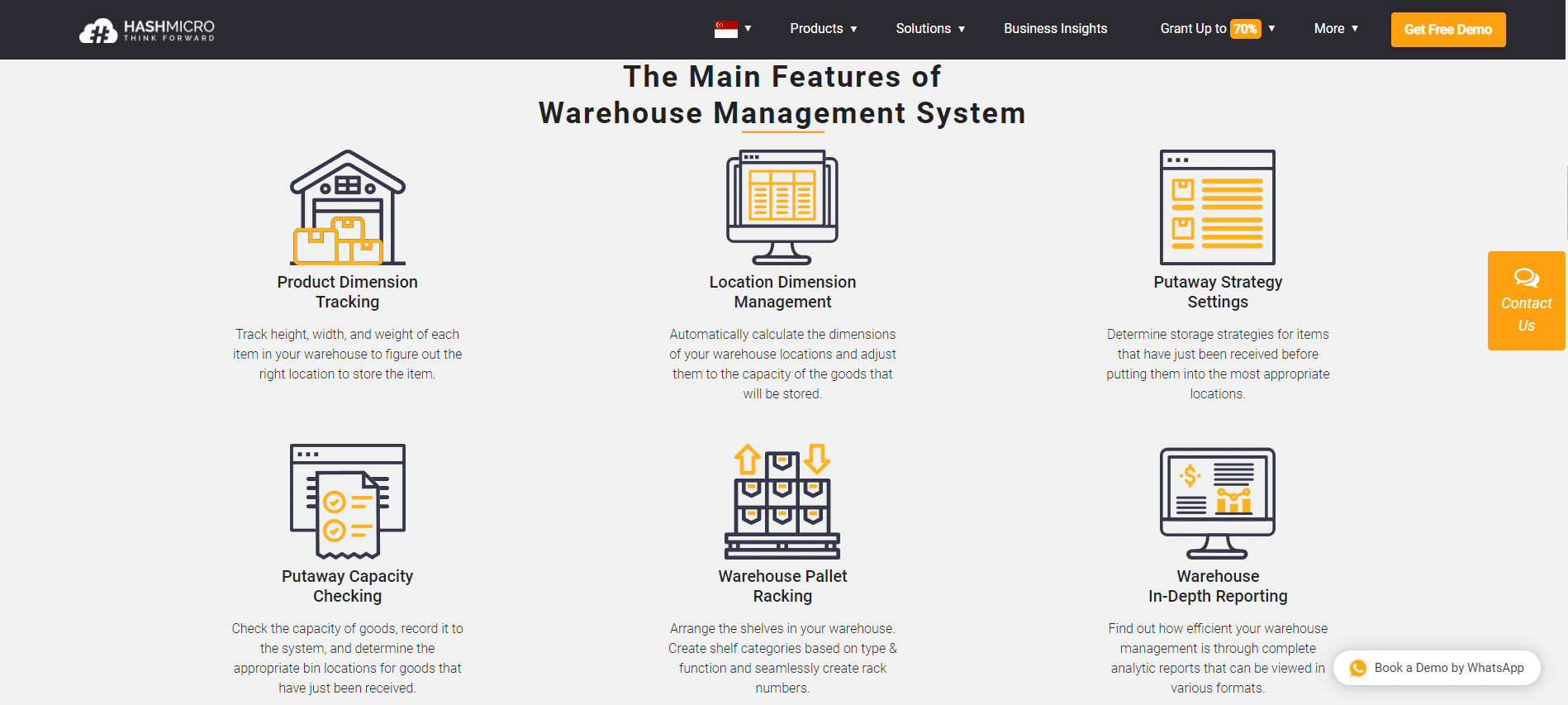Managing inventory efficiently is essential for businesses to ensure smooth operations and timely deliveries. A Warehouse Management System (WMS) helps streamline warehouse processes, from tracking stock to optimizing storage.
Many businesses struggle with inventory mismanagement, leading to stock shortages, overstocking, and delays in order fulfillment. This is why WMS is crucial in ensuring smooth and automated warehouse operations.
One of the best WMS solutions is HashMicro WMS, which is known for its automation and seamless integration. It optimizes warehouse workflows, ensuring accurate tracking and efficient stock control. With AI-driven insights, businesses can improve productivity and profitability.
This article will explore WMS, its importance, and how it differs from supply chain management.
Key Takeaways
|
Table of Content:
Table of Content
What is a Warehouse Management System?
Warehouse management systems (WMS) are used in manufacturing and retail to track materials and goods entering and leaving the warehouse. In basic terms, a WMS helps optimize all your warehouse processes.
It follows all the materials in your warehouse and can create systems to streamline how workers pick products and pack orders. It lets you track merchandise entering the warehouse, loaded onto shelves and other places, and leaving the warehouse for order fulfillment.
When a customer sends an order, the warehouse management system can immediately check if the products are available. Instead of manually cross-referencing the order and stock, the WMS will automatically mark the order as ready for packing.
This saves a great deal of time and effort. Many WMS services end up paying for themselves when used effectively.
What is Supply Chain Management Systems?
A supply chain management system is the management of the flow of goods and services, including raw materials, work-in-process inventory, and finished goods. The markets these days are transcending borders, and managing the demand-supply quotient is increasingly getting complex.
Production centers are set up where the raw materials and labor are cheaper. Raw materials sourcing and finished goods distribution are done globally. Supply Chain Management refers to all business processes and activities, from sourcing raw materials to manufacturing and distributing finished goods.
SCM, in short, is the art of providing the right product at the right time, place, and cost. As inferred, SCM gets much wider in scope than WMS. WMS is perhaps the last mile in the SCM system, and any hitch in its efficacy affects SCM.
Types of Warehouse Management Systems
Improved inventory visibility, increased order fulfillment, and automated data collecting are all benefits of choosing the appropriate warehouse management system. It’s crucial first to comprehend the many sorts of WMS to select the best ones.
Warehouse management software is available in four different configurations: standalone, as a module of supply chain management systems software, as an ERP system, and as a cloud-based solution. Here are the four types of it:
Integrated Vs. Standalone WMS
You may utilize two kinds of warehouse management system software to handle your incoming and existing product activities. The addition of an integrated WMS is often offered by your current Enterprise Resource Planning (ERP) supplier.
The generation of invoices and accounting and inventory management are all under the control of ERP systems. The WMS receives the orders, controls inventory, and oversees product receipt and shipment. It’s easier to track which orders are best to invest in when everything is in one system.
If a product sells well but has a low-profit margin, refill it with a higher profit and lower sales. If you integrate your WMS, you will be able to monitor all of your financial data. A software that exclusively focuses on warehouse management and has multiple features is referred to as a standalone WMS.
As a result, it could only be partially usable for other facets of your company, such as bookkeeping or inventories. Since it’s designed for warehouse management, this WMS may include extensive reporting tools to help you level up your warehouse. Overall, it relies on how you handle priorities in your warehouse.
On-Premises Vs. Cloud-Based WMS

An on-premises WMS is one in which you host and manage the hardware and software. This gives you total control over uptime and security, but it’s expensive since you own all the components. In addition, you will need to ensure that your WMS receives routine maintenance.
Extremely small organizations might find it manageable to use on-premises WMS, but handling all the tasks by themselves could be difficult. As another option, cloud-based WMS systems are hosted on a remote server and are usually charged on a subscription basis.
The vendor handles problem repairs and software upgrades, and you get guaranteed service uptime. It would help if you considered the most efficient technique to take all items as your online retail firm expands.
The warehouse must eliminate confusion since customers have high expectations for shipment and even order packing. Saving all the time and resources needed for on-premises systems may be an excellent approach.
Also read: How to Improve Order Picking Productivity in Your Warehouse
Warehouse Management System Features
- Storage strategy setting: Businesses may make the most of putting freshly arrived products in storage before they reach the warehouse. Additionally, it keeps an eye on warehouse capacity, quickens pick-and-pack, keeps track of item locations, and reduces dead stock.
- Warehouse shelf arrangement: Businesses may control stock placement according to product type, which works with horizontal and vertical warehouse shelving systems.
- Track stock movement: Keep precise and real-time track of each stock movement from the incoming to outgoing process (goods going in and out).
- WMS software report: Comprehensive analytical reports in different forms are available to businesses, allowing them to see how effective warehouse management is.
- Maximize warehouse capacity effectively: With the help of this technology, the warehouse can keep goods efficiently and quickly monitor them as required.
- Checking the capacity of goods: To simplify the process of measuring and documenting the volume of products before storing them in the warehouse
- Item dimension management: Automate the measurements of each area in the warehouse so that arriving items may be easily adjusted. Companies may monitor each item’s height, breadth, and weight in the warehouse for optimal placement on shelves/locations.
- Barcode scanner integration: With a barcode scanner, businesses can increase the accuracy of selecting and packaging consumer orders. Combining this integration with barcode tracking software allows for real-time inventory updates and improved operational efficiency.
- Monitor item availability: In a single, centralized system, keep track of the quantity and location of every item in several places simultaneously.
Differences Between Supply Chain and Warehouse Management Systems
Supply Chain Management Systems (SCM) and Warehouse Management Systems (WMS) are both software systems that are used in logistics and supply chain management. WMS is part of the Supply Chain Management systems (SCM).
Supply Chain Management System (SCM) focuses on suppliers, manufacturers, and retailers, while a Warehouse Management System (WMS) focuses on warehouse logistics, storage, warehousing, and movement of goods. Here are some details differences between SCM and WMS:
1. Scope
SCM is a broader term that encompasses the entire supply chain, from the procurement of raw materials to the delivery of finished products to customers. WMS, on the other hand, is focused specifically on managing the operations of a warehouse or distribution center.
2. Functionality
Supply chain management systems are designed to manage and optimize the entire supply chain, including procurement, inventory management, transportation, and logistics.
In contrast, the Warehouse Management System (WMS) focuses on managing inventory within a warehouse or distribution center, which includes receiving, storage, picking, and shipping.
3. Integration
SCM systems are designed to integrate with a variety of other systems, such as Enterprise Resource Planning (ERP) systems, Transportation Management Systems (TMS), and Customer Relationship Management (CRM) systems.
WMS systems may also integrate with these systems, but their primary focus is on managing warehouse operations.
4. Data
Supply chain management systems collect and analyze data from the entire supply chain, while warehouse management systems focus mainly on data related to warehouse operations.
SCM systems may collect data on supplier performance, transportation costs, and customer demand, while WMS focuses on data related to inventory levels, order fulfillment, and warehouse efficiency.
5. Objectives
The main objective of Supply Chain Management systems is to optimize the entire supply chain to meet customer demand while minimizing costs. The main objective of WMS systems is to optimize warehouse operations to ensure that inventory is available to fulfill customer orders in a timely and efficient manner.
Benefits of Warehouse Management System
The use of warehouse management systems (WMS) has transformed how companies handle their inventory and warehouse activities. This section will explore the benefits of WMS and how they can aid companies in accomplishing their operational and strategic goals.
- Improved inventory accuracy: The warehouse management system uses barcoding, scanning, and RFID technologies to track inventory levels in real time. This reduces the risk of stock-outs, overstocking, and misplacement of inventory.
- Increased productivity: A WMS streamlines warehouse operations, reducing the time and effort required for tasks such as picking, packing, and shipping. This frees up staff to focus on higher-value tasks, such as optimizing processes and improving customer service.
- Optimized warehouse space: A warehouse management system can help businesses make better use of their warehouse space by optimizing the layout and location of products. This can lead to more efficient storage and picking processes, as well as reduced transportation costs.
- Better customer service: With a warehouse management system (WMS), businesses can fulfill orders faster and with greater accuracy. This leads to improved customer satisfaction and loyalty.
- Better supply chain management: WMS software provides greater visibility into the supply chain, enabling businesses to track inventory levels, monitor supplier performance, and identify areas for improvement. This can help businesses reduce costs, improve efficiency, and respond more quickly to changes in demand.
Also read: Solving Main Problems in Supply Chain with SCM Application
Tips for Choosing Warehouse Management Systems

By comprehending the essential aspects to assess, such as scalability, flexibility, customization, and integrations, you can guarantee the selection of a WMS that simplifies your procedures, enhances effectiveness, and elevates revenues.
1. Identify your needs
First, make a list of the features and functionalities that you need from a WMS. Then, determine your business requirements and prioritize them. After that, choose a WMS that can scale with your business.
Finally, look for a solution that can handle increasing order volumes, expanding product lines, and growing sales channels. This ensures that the WMS can continue to meet your needs as your business grows.
2. Evaluate different systems
Research different WMS solutions in the market and compare them against your business requirements. Look for WMS solutions that have a proven track record and a solid reputation in the industry.
It is crucial to take into account the vendor’s maintenance and support services because you will require continuous assistance to guarantee the optimal performance of your WMS
3. Consider integration
If you are already using other software systems in your warehouse, such as an inventory management system, look for a WMS that can integrate with your existing systems. Ensures that the WMS can work seamlessly with your existing workflows and data.
4. Ease of Use
Choose a WMS that is user-friendly and easy to use. The system should be intuitive and require minimal training. This ensures that your team can quickly learn how to use the WMS and increase productivity.
5. Look for Flexibility and Customization
Look for a WMS that is flexible and can adapt to your unique business processes. The system should allow for customization and configuration to fit your specific requirements. This ensures that the WMS can work seamlessly with your existing workflows and can be tailored to your business processes.
6. Look for support
Choose a vendor that offers good customer support and training. The vendor should be available to assist when needed.
7. Consider cost
The cost of a WMS varies widely, so make sure you understand the pricing structure and any additional costs associated with implementation and training.
Conclusion
The primary aim of supply chain administration is to match supply with demand. For this to work, the supply chain should be free from bottlenecks such as errant supplies, difficulty in sourcing, and others.
Until recently, people seemed significantly confused about the phrases SCM and WMS, and they frequently used them interchangeably. However, the logistics industry has generally accepted that warehouse management refers to the storing, stocking, and movement of goods within a warehouse.
The term Supply Chain has a much broader focus involving suppliers, manufacturers, and retailers. By providing customer-centric operations in warehousing, companies gain a competitive advantage. SCM tools help manage the supplies effectively, keeping inventory at optimum levels. The efficiency of SCM relies largely upon the efficiency of WMS.
The SCM’s primary concern is to find out the best storage levels, which the WMS attempts to address. Therefore, it is seen that the SCM & WMS are only complementary and not competing.
The Warehouse Management system also complements the Sales Management System by shortening the sales cycle through quick data access and quality service delivery. Apply for a free demo today and gain the solution that your business needs.






































